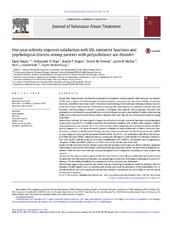| dc.description.abstract | Introduction: Polysubstance use disorder is prevalent in treatment-seeking patients with substance use disorder (SUD), with a higher risk of developing comorbid psychiatric symptoms, more pervasive deficits in cognitive functions, and inferior treatment results. The present study investigates if individuals with polysubstance use disorder who achieve at least one year of abstinence show greater improvements in satisfaction with life, executive functions, and psychological distress, compared to relapsers and controls. The prospective recovery from polysubstance use disorder assessed with broad output indicators remains understudied. A better understanding of the pattern of recovery of the chosen output indicators could shed light on the recovery process for this group of patients. Material and methods: We investigated changes in satisfaction with life, executive functions and psychological distress over a period of 12 months in patients who remained abstinent and in those who relapsed. Subjects with polysubstance use disorder (N = 115) were recruited from outpatient and residential treatment facilities; healthy controls (N = 34) were recruited by posters exhibited at social welfare and GP offices. Executive functions were assessed by the Behaviour Rating Inventory of Executive Function-Adult self-report version (BRIEF-A), psychological distress by the Symptom Checklist-90-R (SCL-90-R), and satisfaction with life by the Satisfaction With Life Scale (SWLS). Substance use was assessed by self-reports on the Alcohol Use Disorders Identification Test (AUDIT) and the Drug Use Disorders Identification Test (DUDIT). Participants were categorized as “relapsers” if they had AUDIT score ≥ 8, or DUDIT score ≥ 2 for women and ≥ 6 for men. Results: Results indicated that the abstinent group had the greatest improvement on all the indicators compared with relapsers and controls. Participants who successfully quit substance use for one year showed improved satisfaction with life, executive functions, and psychological distress compared to participants who relapsed and controls. Conclusions: Our study provides support for the view that there is a clinically and statistically significant recovery of satisfaction with life, executive functions, and psychological distress for SUD patients following one-year of abstinence. This knowledge highlights the importance of time and continued abstinence. Our findings suggest that a gradual and careful step-up of learning requirement should be adopted, and SUD treatment should initially focus on stabilizing the patient and achieving abstinence, while interventions for co-morbid problems and more cognitively demanding treatment components are more likely to succeed later in the treatment sequence. | en_US |

